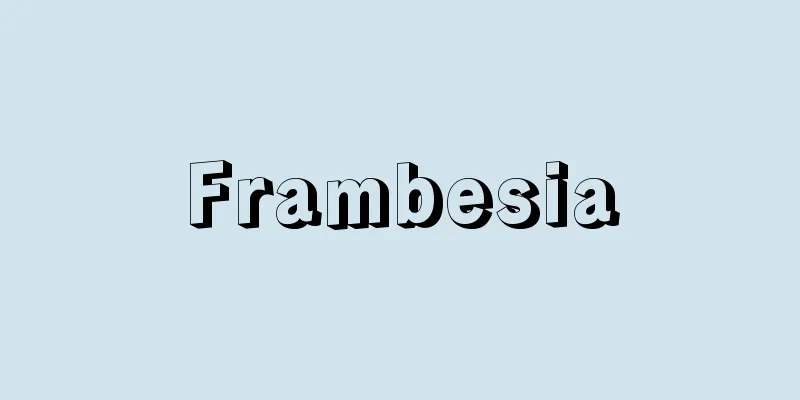Venezuela - Bolivarian Republic of Venezuela (English spelling)

|
In Spanish, it is called Venezuela. The official name is the Bolivarian Republic of Venezuela (República Bolivariana de Venezuela, changed from the Republic of Venezuela in December 1999). It is a republic in the north of South America, facing the Caribbean Sea, bordering Guyana to the east, Brazil to the south, and Colombia to the west. Its area is 912,050 square kilometers, about 2.4 times that of Japan. Its population is 27,227,930 (2011 census), with a population density of 30 people per square kilometer. Its capital is Caracas. The country's name means "Little Venice." An explorer in the Columbus era gave it this name because the floating houses on the Bay of Venezuela resembled Venice in Italy. It was once a poor agricultural country affected by the mountainous nature and climate, but the discovery of oil in the 1910s completely transformed its economic structure. [Shozo Yamamoto] Nature and GeographyThe country is located between the equator and 12 degrees north latitude. There are three mountain ranges in the west, north, and south, including the Sierra Mérida and Sierra Pelija mountains in the west, the Caribbean Coast Mountains in the north, and the La Parima and Pacaraima mountains in the south, all of which are high mountains over 4,000 meters high. The country is divided into four regions: (1) the Venezuelan Highlands, which is the core of the country; (2) the Maracaibo lowlands, which are home to world-class oil fields; (3) the central plain known as the Llano; and (4) the Guiana Highlands, which make up about half of the country's land area. (1) The Venezuelan Highlands are one of the northernmost branches of the Andes. The branch that branches off northeast from near the border with Colombia is called the Sierra de Mérida and continues to the Segovia Highlands on the east side of Lake Maracaibo. The Central Highlands run east from the Segovia Highlands along the coastline, and the Northeastern Highlands are isolated further east. The Central Highlands and the Northeastern Highlands are 2,000 to 3,000 meters above sea level. The highlands and mountain basins provide comfortable living conditions despite being in the tropics, and the capital Caracas and other major cities in Venezuela are concentrated in the basins of this region. In addition, the country is blessed with abundant precipitation, and sugar cane, cotton, cacao, and coffee for export are intensively cultivated around Lake Valencia in the Central Highlands. Corn and beans are also produced for self-sufficiency, but food is not yet sufficient for self-sufficiency. The Sierra de Mérida is the main producer of coffee. During the second half of the 20th century, Venezuela's economic focus gradually shifted to the northern edge of the Guiana Highlands, but the Venezuelan Highlands remain the most densely populated, productive agricultural region, and center of urban life. (2) The Maracaibo lowlands are a lowland area centered around Lake Maracaibo, and are surrounded to the west by the Sierra de Perija mountain range, which forms the border with Colombia, and to the southeast by the Sierra de Merida, a branch of the Andes. The average temperature is the highest in South America, and the humidity is also high. As you move from the Sierra de Merida to the coast, the amount of precipitation gradually decreases, and the vegetation changes accordingly. As a result, all kinds of tropical fruits are produced. Until the world-class oil fields were discovered here in 1917, the land was unsuitable for habitation. (3) The Central Plain is an alluvial plain in the basin of the Orinoco River, the third largest river in South America, and occupies about one-third of the country's land area. Except for the jungle area in the east and a small hilly area to the west of the vast delta area of over 20,000 square kilometers, the area is covered with vast grasslands (llanos) and is the center of livestock farming. It is dry in winter and rainy in summer, causing rivers to flood. (4) The Guiana Highlands are located south of the Orinoco River and occupy about half of the country's land area, but the inhabitants are only about 5% of the total population (2011). For a long time it was underdeveloped, but since 1958, intensive development has been promoted with the aim of industrializing the northern part of the highlands. Blessed with mineral resources such as gold, diamonds, and high-quality iron ore, it is attracting attention as a resource second only to oil. The world's largest waterfall, the 972-meter-high Angel Waterfall, is located on a cliff on the northern edge of the Gran Sabana. In terms of the river system, the Orinoco irrigates about 80% of the country, and its tributaries include the Caroni, Apule, Caura, and Arauca rivers. The Orinoco River is 2,736 km long, and ocean-going steamships can sail from its mouth to Ciudad Bolivar, 420 km upstream. The country's largest lake is Lake Maracaibo, with an area of about 13,000 km2, which is important as a means of exporting oil because it connects to the Gulf of Venezuela and allows ocean-going steamships to enter and leave. Lake Bermudez, located upstream of the San Juan River, has a surface covered with asphalt one meter thick. The country's highest mountain is Mount Bolivar, 5,007 meters high, located in the Sierra de Mérida mountain range. [Shozo Yamamoto] historyVenezuela, which Columbus arrived in on his third voyage in 1498, became the first Spanish colony in South America. Although it was a remote region lacking the charm of El Dorado (the City of Gold), it prospered through the production and trade of tropical agricultural products. In 1717, it was integrated into the Viceroyalty of New Granada, and in 1777, under the reforms of Carlos III, it was elevated to the Viceroyalty of Venezuela, and the Audiencia (Great Inquisition) was established in Caracas (1786). The criollos (Spaniards born in the "New World"), who sought complete trade liberalization, resonated with the ideas of the European Enlightenment, and began pioneering the Latin American independence movement. After Napoleon's army invaded Spain (1808), Venezuela declared independence in 1811 under the leadership of Francisco de Miranda and Simon Bolivar, but because they did not take the Llaneros (cattle herders) and African people into consideration, they were used by the royalists and were defeated by Spain. Bolivar, who took the lead in the movement, liberated the Andean countries from Spain with the cooperation of the Llaneros, Britain, Haiti, and others, and in 1819 established the Republic of Gran Colombia, which included Colombia and Ecuador. Venezuela separated from the Republic of Gran Colombia and became independent in 1830, and the country was devastated during the long war of independence. For about a century after independence, the country experienced violent rule by military commanders (caudillos), with the rise of anti-dictatorial forces, and around 50 coups. The first president, José Antonio Páez (in office 1830-1835, 1839-1843, 1861-1863), was a native of the Ilanero tribe, and established a conservative oligarchy with the support of the military and merchants in Caracas. However, the Liberal Party, which advocated anti-dictatorial and anti-clerical policies (opposed to the authority of the Catholic Church), rose to power, and the conflict between the centralist (conservative) faction and the federalist (liberal) faction escalated into the Federal War in the mid-19th century, with the federalists taking real power. Then, from the end of the 19th century until the end of World War II, caudillos of Andean origin (Andino) held the reins of power. In particular, President Juan Vicente Gómez (in office 1908-1928, 1931-1935), known as the "Tyrant of the Andes," used the secret police to create the foundations for a unified state, and invited foreign capital to begin oil development. In 1928 during Gómez's reign, an anti-dictatorship organization was formed, mainly by students at the Central University of Caracas, which later developed into the Democratic Action Party (AD: Acción Democrática), a driving force behind modernization. In the midst of the global trend towards democratization after World War II, the AD, teaming up with young officers, seized power in a coup in October 1945 and introduced a series of reforms. Universal suffrage was realized, opening the way to political participation and party politics. However, military personnel who resisted the reforms staged a coup in 1948, preparing the way for the dictatorship of Pérez Jimenez (in office 1952-1958, ignoring elections and becoming president). Jimenez, who gained the support of the United States during the Cold War, left oil development to foreign capital, pursued a growth policy, and intensified oppression of critics, but was ousted in 1958 by an anti-dictatorship movement that gained momentum after he tried to stay put. Rómulo Betancourt (1959-1964), who was elected president of the Democratic Party of the United States, signed the Punto Fijo Agreement with three parties (later consisting of the Democratic Socialist Party of the United States and the Democratic Socialist Party of the United States), including the Christian Socialist Party (COPEI: Comité de Organización Política Electoral Independiente), to provide each other with ministerial posts, and he sought political stability by embarking on land reform, industrialization, and nationalistic oil policies. He suppressed the activities of pro-Cuban guerrillas, suppressed the rise of the military, and solidified the foundations of civilian rule. The AD government of Raúl Leoni Ostero (1905-1972) who succeeded him continued Betancourt's center-left policies, but in 1968 Rafael Antonio Caldera Rodríguez (1916-2009) of COPEI won, realizing a peaceful change of government and implementing moderate reforms based on ideological pluralism (1969-1974). The AD government of Carlos Andrés Pérez (1974-1979), which came into power immediately after the oil crisis, pursued an active diplomacy against the backdrop of rising oil prices, preached resource nationalism at the United Nations, and nationalized oil in 1976. However, due to the government's extravagant finances and political corruption, the government was transferred to Luis Antonio Herrera Campins (1925-2007) of COPEI (1979-1984), but he was unable to deal with the accumulated debt problem, and Jaime Ramón Lusinchi (1924-2014) of AD took over the government (1984-1989). However, the state-led development path based on oil revenues and a two-party system had already reached its limits. The second AD administration of Pérez changed the policy and introduced a neoliberal economic policy, but immediately after taking office, a major riot (Caracazo) broke out in the capital Caracas in February 1989 in protest against the new policy, and the country was hit by military rebellions in February and November 1992. Pérez was then arrested in May 1993 on charges of embezzlement of public funds. In the 1993 presidential election, former President Caldera ran for the National Unity Party (CN: Convergencia Nacional), which he had formed after leaving COPEI, and was elected, bringing an end to the cooperative two-party system. In 1998, Hugo Chavez, a former army lieutenant colonel who had staged a military coup in 1992, was elected president with the support of the poor. The following year, in 1999, a new constitution drafted by the Constituent Assembly was approved in a national referendum, and the country's name was changed to the Bolivarian Republic of Venezuela. The presidential term was also extended from five years to six years (up to two consecutive terms were possible), and the parliament was reduced from a bicameral to a unicameral system. In 2000, Chavez was elected president under the new constitution (he was re-elected if elections under the old constitution were included), and he enacted 49 laws, including the Land Law and the Hydrocarbons (oil and natural gas) Law, under the Presidential Enabling Law (which allows the president, not parliament, to enact laws for one year) (2001). Opposition to Chavez's radical and heavy-handed methods spread primarily among the military, business circles and labor unions, and escalated into large-scale demonstrations and strikes following the replacement of officials at the state-run Venezuelan oil company (PDVSA: Petróleos de Venezuela, SA). Chavez was arrested in a coup in April 2002, but was returned to the presidency two days later following protests from his supporters. Economic activity stagnated, but support for the poor was strengthened. Thus, Chavez was approved as president in a national referendum in August 2004, and won a landslide victory in the 2006 presidential election (with 63% of the vote). Chavez, who was inaugurated as president for his third term (second term under the new constitution) in 2007, declared the nationalization of electricity, communications, etc., closed down private television stations that were anti-Chavez, and in December lost by a narrow margin in a national referendum on constitutional reform (aiming to transition to socialism, abolishing the one-time re-election provision for the president and extending the term of office to seven years). However, in February 2009, he won a national referendum on amending the constitution to abolish the re-election limit for elected office (54% in favor), and Chavez ran in the 2012 presidential election and was elected for a fourth term. Following Chavez's death in 2013, presidential elections were held and Nicolás Maduro Moros (1962- ) was elected. [Hiroko Nori] Politics and DiplomacyVenezuela, which transformed rapidly from a politically turbulent agricultural country into a modern nation supported by oil, maintained civilian rule during the 1960s and 1970s, when South American countries were subject to military rule. The foundations of this "Venedemocrasia" (Venezuelan democracy) were a two-party system and oil wealth, but politics were monopolized by the two major parties, left-wing forces were prevented from participating in politics, and corruption became widespread. In addition, oil prices fell in the 1980s, and the neoliberal economic policies to deal with foreign debt had a direct impact on the lives of the people, leading to a decline in the income of the middle class and an increase in the number of poor people. President Chavez, who came to power under the banner of the "Bolivarian Revolution," dreamed of realizing the ideals of independence fighter Bolivar (independence and solidarity in Latin America). To that end, he aimed for socio-economic justice through the participation and mobilization of people excluded from politics, and poured his energy into the formation of a strong centralized state and solidarity in Latin America to make this possible. He solidified the support of the people by using oil money to combat poverty (housing, medical care, education, etc.), but the backlash from the opposition divided the nation (polarized it). Furthermore, constitutional reforms expanded and strengthened the executive branch and weakened the legislative and judicial branches (appointing Chavez supporters), strengthening the president's dictatorial power and shaking the foundations of democracy. Chavez's goal through the Bolivarian Revolution was to build a "21st century socialist" society. A proposed constitutional amendment to socialize the country was rejected in a national referendum in 2007, but the party went ahead with the formation of the United Socialist Party of Venezuela (PSUV: Partido Socialista Unido de Venezuela), the nationalization of major industries, and the institutionalization of participatory democracy through People Power (composed of committees of workers, farmers, students, and local residents). Conflicts with dissidents, as well as increased arrests of dissidents and prosecution as political prisoners, raised the question of whether socialism and democracy could coexist. The political system is a republic, with a federal system. The Constitution of the Bolivarian Republic of Venezuela was enacted in 1999. The head of state is the president, who serves a six-year term. The National Assembly is unicameral (167 seats). The national military consists of four branches: the army, navy, air force, and national guard, with a total of 115,000 troops, with selective conscription. The defense budget is approximately $4.65 billion (2014). Since the United States completely banned arms sales to Venezuela in 2006, cooperation with Russia has been strengthened, and Venezuela has received $4.4 billion in weapons, and in December 2008, it conducted joint exercises with the Russian fleet in the Caribbean. The Chavez administration, which advocated anti-neoliberalism, was a pioneer of the left-wing governments in Latin America that were critical of the neoliberalism that subsequently increased, and along with Cuba and Bolivia, it belongs to the far left. He built multilateral diplomatic relations using oil as a negotiating weapon, and promoted the Bolivarian Revolution through global solidarity with left-wing governments and former socialist countries. In 2006, in reaction to the free trade agreement (FTA) concluded between the United States and pro-American Colombia and Peru, Chavez withdrew from the Andean Community, but joined the Southern Common Market (MERCOSUR), which is composed of Brazil, Argentina, and others. Tensions temporarily rose with neighboring Colombia (2008) when the Colombian military violated the border with Ecuador (left-wing Correa administration) during the sweep of the left-wing guerrilla Revolutionary Armed Forces of Colombia (FARC: Fuerzas Armadas Revolucionarias de Colombia). In opposition to the US-led Free Trade Area of the Americas (FTAA) initiative, in 2004 it proposed the Bolivarian Alternative to the Americas (renamed the Bolivarian Alliance for the Americas in 2009, both abbreviated as ALBA) together with Cuba and Bolivia, and Nicaragua, Ecuador, and Caribbean countries are members of the initiative. This initiative aims for economic and political integration within the region through medical and educational cooperation and resource complementation, and is also planning mutual energy supplies with Brazil, Argentina, and others. After the US government was suspected of involvement in the 2002 coup, Chavez called US President Bush the devil at the UN, and the US was concerned about the Chavez administration's support for the FARC. In 2008, the US expelled its ambassador from Bolivia in sympathy with the Morales administration. Meanwhile, the US also expelled its Venezuelan ambassador, and both countries asked each other to expel their ambassadors, but in 2009, they were able to reciprocally redeploy their ambassadors, hoping for an improvement in relations from the Obama administration. Traditionally, the US has been the largest customer for Venezuelan oil (about 50% of total exports), but this is on the decline. Venezuela has turned its attention to China as a new destination for its oil exports. In 2001, an agreement was signed to supply Orinoco extra heavy oil (Orinoco tar) to China, and in 2008, state-run Petroleum de Venezuela and China Petroleum agreed to build the first joint venture refinery in Guangdong Province. Venezuela also has close ties with Russia, with the leaders of the two countries making mutual visits, and Russia promising to support Venezuela's oil exploration and the construction of nuclear power plants. Chavez pursued a diplomatic policy of solidarity with the Third World, and in 2000, as head of state of the Organization of the Petroleum Exporting Countries (OPEC), he visited Iraq to discuss stabilizing oil prices. In 2002, as chair of the Group of 77 developing countries (G77), he called for cooperation among developing countries to counter neoliberal economics, and made a similar proposal at the Caracas meeting of the Group of 15 developing countries (G15) in 2004. [Hiroko Nori] economyDuring the colonial period, Venezuela was known as a producer of tropical agricultural products, and after independence, it was an agricultural country that exported bananas and meat in addition to cacao, coffee, and sugar due to the free trade policy. In the 1910s, oil extraction began with Western capital, and Venezuela became one of the world's leading oil exporters. Venezuela's active lobbying of Middle Eastern oil-producing countries led to the establishment of the Organization of Petroleum Exporting Countries (OPEC) in 1960. The government's oil policy has followed a process of national control based on the demand for a fair profit share from international oil capital, and has been in sync with OPEC's policy of raising prices through production adjustments. Venezuela's profit share rate, which was only 7% in 1936, increased to 50% in 1945 and 72% in 1975, and oil was nationalized in 1976. As of 2014, Venezuela is the 11th largest crude oil producer in the world, and about 80% of its exports and 40% of its revenue are dependent on oil. Due to the fact that the recoverable reserves of extra-heavy oil on the north bank of the Orinoco River are increasing year by year, the country's recoverable oil reserves reached 298.3 billion barrels in 2014, making it the largest in the world, surpassing those of Saudi Arabia. Chavez, who advocated a socialist revolution, declared that the oil policies of previous administrations had benefited a select elite, and advocated resource nationalism to return benefits to the people. He reversed the trend of privatization that had progressed in the 1990s, establishing state-run enterprises in agriculture, food distribution, finance, and other sectors, and in 2007 nationalized strategic industries such as electricity, communications, and the Orinoco extra heavy oil project. In 2008, he announced the nationalization of the cement industry, the steel company SIDOR, and gold mines, followed by the nationalization of oil-related businesses and steel-related companies in 2009. Due to political unrest and strikes, the GDP growth rate fell to negative in 2002, but it turned to high growth from 2004 onwards due to the rise in oil prices. However, production activities stagnated and the growth rate dropped again, falling into negative growth in 2009 and 2010. In addition, the expansion of poverty measures and inefficient economic management led to an expansion of government expenditures, and the inflation rate rose to 27% (2009). In January 2008, the currency was denominated (the unit of currency was changed), and 1,000 bolivars became 1 bolivar fuerte. The future of the Bolivarian Revolution, which is overly dependent on oil, is not secure. In 2014, exports were $79.5 billion, about 80% of which was oil, and imports were $51.5 billion, mainly industrial raw materials and machinery. The main trading partners for both imports and exports are the United States and China. [Hiroko Nori] Society and CultureRacially, mestizos (mixed race of white and indigenous people) make up the majority at 66%, followed by whites at 22% and Africans at 10%, all of which are concentrated in the coastal areas, while indigenous people make up only 2%, and live in the Guiana Highlands and on the west shore of Lake Maracaibo. The official language is Spanish, but English is widely spoken in business and government agencies. The constitution guarantees freedom of religion, but Catholicism is dominant, with Protestants making up less than 10% of the total population. In terms of education, the government allocates more than 10% of the national budget to promote education, and compulsory education is 10 years from age 6. The school attendance rate is estimated at 94.8% (2011), and the literacy rate at 95.5% (2009). There are 20 universities, including the Central University of Venezuela in Caracas, but the level of education is extremely disparate. This reflects Venezuela's economic problems. Although it is considered a wealthy country blessed with abundant oil resources, in reality there is a large gap between the rich and the poor, and there are many unemployed people. A large number of people have flowed from rural areas to cities, and slums have formed all over the cities. Incidentally, the urban population is 89% of the total population (2014). Venezuela's labor policy is extremely progressive, and workers are allowed to participate in the pursuit of profits, equal pay must be given for equal work, and the government can force the minimum wage. Culture and customs vary greatly from region to region. Famous cultural figures include the 19th century world-renowned humanist Andres Bello and former president and writer Rómulo Gallegos. In terms of sports, baseball is as popular as soccer. [Shozo Yamamoto] Relations with JapanDiplomatic relations were established in 1938 (Showa 13), but Venezuela severed diplomatic relations with Japan during World War II in 1941, and declared war on Japan in February 1945. Diplomatic relations were restored in 1952 (Showa 27). There are 443 Japanese people living in Japan (as of October 2014), and 380 Venezuelans living in Japan (as of December 2012). Prewar immigrants were re-emigrants from Peru and other countries, and after the war these immigrants began inviting people to Japan, and in recent years the number of Venezuelans living in Japan has increased due to business relationships. Economic exchanges between the two countries are vibrant, with direct investment from Japan reaching a cumulative total of 23.5 billion yen between 2005 and 2009 (cumulative total up to 2004 was $770 million). In 1975, the Japan-Venezuela Economic Cooperation Council (JAVEC) was formed, and financial and technical cooperation has been carried out. An example of this is the Orinoco Tar Lightening Project, and in 2010, a consortium of Japanese and American companies participated in the development of part of the Orinoco Heavy Oil Belt. Also, in 2009, the state-run Petroleum de Venezuela agreed with Japanese, American and European companies, including Mitsubishi Corporation, to jointly carry out a $19.6 billion liquefied natural gas (LNG) project. In 2013, exports to Japan totaled 49.2 billion yen in aluminum ingots, iron ore and cocoa beans, while imports totaled 66 billion yen in machinery and equipment, including automobiles. [Hiroko Nori] "Latin America 2" by PE James, translated by Yamamoto Shozo and Kanno Mineaki (1979, Ninomiya Shoten)" ▽ "Modern Latin American History II" by Nakagawa Fumio, Matsushita Hiroshi and Osonoi Shigeo (1985, Yamakawa Publishing)" ▽ "An Outline of the History of Venezuela" by Guillermo Moron Montero (1993, Latin American Association)" ▽ "Geography of the World 5 - South America" edited by Tanabe Yutaka (1997, Asakura Shoten)" ▽ "Left-wing Governments in Latin America in the 21st Century: Illusion and Reality" edited by Osonoi Shigeo and Usami Koichi (2008, Institute of Developing Economies)" [References] | | | | | | | | | | | | | | | | | | | | | [Additional resources] |"> Venezuela flag ©Shogakukan Illustration/Shogakukan Creative "> Venezuela Location Map Source: Shogakukan Encyclopedia Nipponica About Encyclopedia Nipponica Information | Legend |
|
スペイン語ではベネスエラ。正式名称はベネズエラ・ボリバル(ボリーバル)共和国 República Bolivariana de Venezuela(1999年12月ベネズエラ共和国から変更)。南アメリカの北部、カリブ海に面する共和国で、東はガイアナ、南はブラジル、西はコロンビアに接する。面積は91万2050平方キロメートルで、日本の約2.4倍。人口は2722万7930(2011国勢調査)、人口密度1平方キロメートル当り30人。首都カラカス。国名は「小さなベネチア」の意。コロンブス時代の探検家が、ベネズエラ湾の水上の家がイタリアのベネチアに似ているところからこの名をつけた。かつては山岳性の自然と気候の影響を受けて貧しい農業国であったが、1910年代に発見された石油が経済構造を一変させた。 [山本正三] 自然・地誌国土は赤道と北緯12度の間に位置する。西部、北部、南部に3山系があり、そのなかに4000メートル以上の高山が連なる西部のメリダ山脈、ペリハ山脈、北部のカリブ海岸山脈、南部のラパリマ山脈、パカライマ山脈などがある。国土は4地域に分けられる。(1)国の核心地域であるベネズエラ高地、(2)世界的油田のあるマラカイボ低地、(3)リャノとよばれる中央平原、(4)国土の約半分を占めるギアナ高地である。 (1)ベネズエラ高地はアンデス山脈北端の支脈の一つで、コロンビアとの国境付近から北東に分岐する支脈がメリダ山脈とよばれ、マラカイボ湖東側のセゴビア高地へと続く。セゴビア高地から海岸線に沿って東に走るのが中央高地で、さらにその東に孤立しているのが北東高地である。中央高地と北東高地は標高2000~3000メートルである。高地や山中の盆地は、熱帯圏にもかかわらず気候が温暖なため快適な居住地を提供し、首都カラカスをはじめとしてベネズエラの主要都市がこの地域の盆地に集中している。また豊富な降水量に恵まれ、中央高地のバレンシア湖周辺などでは輸出用のサトウキビ、綿花、カカオ、コーヒーが集約的に栽培されている。また自給用のトウモロコシ、豆類なども生産されているが、食糧は自給には至っていない。メリダ山脈はコーヒーの主産地である。20世紀後半に入ってからベネズエラの経済の重点はしだいにギアナ高地北縁に移動する傾向を示していたが、現在でもベネズエラ高地が最高の人口密度を有し、生産性の高い農業地域および都市生活の中心である。 (2)マラカイボ低地はマラカイボ湖を中心とする低地帯で、西はコロンビアとの境をなすペリハ山脈、南東はアンデスの支脈メリダ山脈に囲まれる。平均気温が南アメリカ最高で、湿度も高い。メリダ山脈から海岸に行くにしたがってしだいに降水量を減じ、植生もこれにしたがって変化する。そのためあらゆる種類の熱帯果実を産する。1917年ここに世界的油田が発見されるまでは、居住に適さない土地であった。 (3)中央平原は南アメリカ第三の大河オリノコ川流域の沖積平野で、全国土の約3分の1を占める。2万平方キロメートル余の広大なデルタ地帯を中心に東部に広がるジャングル地帯とその西のわずかな丘陵地帯とを除いて、一面の大草原(リャノ)をなし牧畜の中心地となっている。冬季に乾燥し、夏季に雨が多く河川が氾濫(はんらん)する。 (4)ギアナ高地はオリノコ川の南にあって国土の約半分を占めるが、住民は全人口の5%程度(2011)にすぎない。長らく未開発状態であったが、1958年以降高地北部の工業化を目ざして強力に開発が進められた。金、ダイヤモンドのほか良質の鉄鉱石など鉱産資源に恵まれ、石油に次ぐ資源として注目されている。世界最大で高さ972メートルのアンヘル(エンジェル)滝がグランサバナ北辺の急崖(きゅうがい)にある。 水系に関しては、オリノコ水系が国土の約80%を潤し、支流としてカロニ、アプーレ、カウラ、アラウカなどの河川がある。オリノコ川は全長2736キロメートルで、河口から420キロメートル上流のシウダー・ボリーバルまで外洋汽船が就航。同国最大の湖は面積約1万3000平方キロメートルのマラカイボ湖で、ベネズエラ湾につながり外洋汽船の出入りが可能なため石油の輸出手段として重要である。サンフアン川上流にあるベルムデス湖は表面が1メートルの厚さのアスファルトで覆われている。同国最高の山は5007メートルのボリーバル山でメリダ山脈に位置する。 [山本正三] 歴史コロンブスが1498年の第3回航海の際に到着したベネズエラは、南アメリカ最初のスペイン植民地となった。エル・ドラド(黄金郷)の魅力に乏しい辺境の地であったが、熱帯農産物の生産と交易によって繁栄した。1717年にヌエバ・グラナダ副王領に統合され、カルロス3世の改革で1777年にベネズエラ総監領に昇格、カラカスにアウディエンシア(大審問院)が設置される(1786)。完全な貿易自由化を求めるクリオーリョ(「新大陸」生まれのスペイン人)はヨーロッパの啓蒙(けいもう)思想に共鳴し、ラテンアメリカ独立運動の先駆的動きを開始した。ナポレオン軍のスペイン侵入(1808)後、フランシスコ・デ・ミランダとシモン・ボリーバルの指導のもと、1811年に独立を宣言するが、ヤネーロ(リャネロス。牛牧民)やアフリカ系の人々を顧慮しなかったため王党派に利用され、スペインに敗れた。運動の主導権を握ったボリーバルはヤネーロやイギリス、ハイチなどの協力を得てアンデス諸国をスペインから解放し、1819年にコロンビア、エクアドルを含む大(グラン)コロンビア共和国を成立させた。ベネズエラが大コロンビア共和国から分離独立するのは1830年で、長い独立戦争の間に国土は荒廃した。 独立後約1世紀の間、反専制を掲げる勢力の台頭を挟みながら軍人統領(カウディーリョ)の暴力的支配が続き、約50回のクーデターを経験する。ヤネーロ出身の初代大統領ホセ・アントニオ・パエス(在任1830~1835、1839~1843、1861~1863)は、軍人とカラカスの商人の支持のもとに保守的寡頭支配を開始した。しかし反専制・反教権(カトリック教会の権威に反対)を掲げる自由党が台頭し、中央集権(保守)派対連邦主義(自由)派の対立は19世紀中葉に連邦戦争に発展し、連邦主義派が実権を握ることになる。ついで19世紀末から第二次世界大戦終了時まで、アンデス出身(アンディノ)のカウディーリョたちが政権を掌握した。なかでも「アンデスの暴君」と称された大統領ファン・ビセンテ・ゴメス(在任1908~1928、1931~1935)は秘密警察を用いて統一国家の基礎をつくり、外資を招いて石油開発を開始した。このゴメス時代の1928年に、カラカス中央大学の学生を中心に反独裁組織が結成され、これがのちに近代化の推進力となる民主行動党(AD:Acción Democrática)に発展する。 第二次世界大戦後の世界的民主化の潮流のなかで、青年将校と組んだADは1945年10月にクーデターで政権を掌握し、相次いで改革を打ち出した。普通選挙制が実現し、政治参加と政党政治への道が開かれた。しかし改革に抵抗する軍人が1948年にクーデターを起こし、ペレス・ヒメネス独裁(在任1952~1958。選挙を無視して大統領に就任)を準備することになる。東西冷戦期アメリカの支持を得たヒメネスは外資に石油開発を任せて成長政策をとり、批判勢力に対する弾圧を強めたが、居座り工作を機に盛り上がった反独裁運動によって1958年に追放された。 大統領に選出されたADのロムロ・ベタンクール(在任1959~1964)は、キリスト教社会党(COPEI:Comité de Organización Política Electoral Independiente)など3党(のちADとCOPEIの2党となる)と互いに閣僚ポストを提供するプント・フィホ協定を結んで政治の安定をはかり、農地改革、工業化、民族主義的な石油政策に着手する。彼はキューバ派ゲリラの活動を鎮圧し、軍の台頭を抑えて文民統治の基礎を固めた。後継のラウル・レオニRaúl Leoni Ostero(1905―1972)AD政権はベタンクールの中道左派政策を継承したが、1968年にCOPEIのラファエル・カルデラRafael Antonio Caldera Rodríguez(1916―2009)が勝利して、平和裡(り)に政権交代が実現し、イデオロギー的多元主義のもとに穏健な改革が進められた(1969~1974)。石油危機の直後に成立したADのカルロス・アンドレス・ペレス政権(1974~1979)は、油価高騰を背景に積極外交を展開し、国連で資源ナショナリズムをうたい、1976年に石油を国有化する。しかしその放漫財政と政治腐敗から、COPEIのエレラ・カンピンスLuis Antonio Herrera Campins(1925―2007)に政権が移行したが(1979~1984)、累積債務問題に対応できず、ADのハイメ・ルシンチJaime Ramón Lusinchi(1924―2014)に政権が受継がれた(1984~1989)。しかしすでに石油収入と二大政党制に基づく国家主導型開発路線は限界にきていた。第二次ペレスAD政権は政策を転換して新自由主義経済政策を打ち出したが、大統領就任直後の1989年2月首都カラカスで新政策に抵抗する大暴動(カラカッソ)が起き、1992年2月と11月には軍の反乱にみまわれた。ついで1993年5月に公金横領の罪でペレスは逮捕される。1993年の大統領選挙では元大統領のカルデラがCOPEIを離れて結成した国民統一党(CN:Convergencia Nacional)から出馬して当選し、協調型二大政党制は終焉(しゅうえん)した。 1998年には、1992年に軍クーデターを起こした元陸軍中佐ウーゴ・チャベスが、貧困層の支持を得て大統領に選出される。翌1999年に制憲議会が作成した新憲法案が国民投票で承認され、国名がベネズエラ・ボリバル(ボリーバル)共和国に変更された。また大統領の任期がこれまでの5年から6年に延期され(連続2期まで可能)、議会は2院制から1院制に縮小された。2000年、新憲法下での大統領選挙で当選(旧憲法下での選挙を含めると再選)したチャベスは、大統領授権法(議会ではなく大統領が1年間法律を制定できる法)により土地法、炭化水素(石油・天然ガス)法など49の法律を制定した(2001)。チャベスの急進的で強引な手法に対する反発は軍・財界・労組を中心に広がり、国営ベネズエラ石油(PDVSA:Petróleos de Venezuela, S.A.)の役職員更迭を機に、大規模なデモやストに発展する。2002年4月のクーデターでチャベスは拘束されたが、チャベス支持派の抗議によって2日後に大統領に復帰した。経済活動は停滞するが、貧困層に対する支援は強化された。こうして2004年8月の国民投票でチャベスは大統領として信任され、2006年の大統領選挙で圧勝した(63%の得票)。2007年に3期目(新憲法下では2期目)の大統領に就任したチャベスは、電力、通信などの国有化を宣言、反チャベス派の民放テレビ局を閉鎖して、12月に憲法改正(社会主義への移行をめざし、大統領の1回限りの再選規定を撤廃、任期を7年に延長)に対する国民投票に僅差(きんさ)で敗れた。しかし2009年2月、公選職の再選制限を撤廃する憲法修正の是非を問う国民投票に勝利し(賛成54%)、チャベスは2012年の大統領選挙に立候補して4選を果たした。 2013年チャベスの死に伴い大統領選挙が行われ、ニコラス・マドゥーロNicolás Maduro Moros(1962― )が当選した。 [乗 浩子] 政治・外交政治的に混乱した農牧国から石油に支えられた近代国家に急速に変貌(へんぼう)したベネズエラは、南米諸国が軍政化した1960年代、1970年代に民政を維持した。この「ベネデモクラシア」(ベネズエラの民主主義)の基盤は、二大政党制と石油の富にあったが、政治は二大政党に独占され、左派勢力は政治参加を阻まれ、汚職が蔓延(まんえん)する。また石油価格は1980年代に下落し、対外債務に対処する新自由主義経済政策は国民生活を直撃、中間層の所得低下と貧困層の増大をもたらした。 「ボリーバル革命」を掲げて登場した大統領チャベスの夢は、独立の志士ボリーバルの理想(ラテンアメリカの自立と連帯)の実現にあった。そのために彼は、政治から排除された人々の参加と動員によって社会経済的正義を目ざし、これを可能にする強力な中央集権国家の形成と中南米の連帯にエネルギーを注いだ。彼はオイルマネーによる貧困対策(住宅・医療・教育など)によって民衆の支持を固めたが、反体制派の反発は国民を二分(両極化)した。また憲法改正によって行政府の拡大強化と立法府・司法府(チャベス派を任命)の弱体化が進み、大統領の独裁的権力が強まり、民主主義の基盤は揺らいでいる。 ボリーバル革命によってチャベスが目標としたのは、「21世紀の社会主義」社会の建設である。社会主義化を内容とする改憲案は2007年に国民投票で否決されたが、ベネズエラ統一社会党(PSUV:Partido Socialista Unido de Venezuela)の結成、主要産業の国有化、人民権力(労働者・農民・学生・地域住民の各委員会から構成)による参加民主主義の制度化が進められた。反体制派との対立、さらには反体制派の逮捕や政治犯としての追及が増え、社会主義と民主主義が両立できるか否かが問題となった。 政治体制は共和制で、連邦制をとる。ベネズエラ・ボリバル(ボリーバル)共和国憲法が1999年に制定された。元首は大統領で、任期6年。国会は1院制(167議席)。国軍は陸海空および国家警備隊の4軍よりなり、兵力は11万5000人で選抜徴兵制。国防予算は約46.5億ドル(2014)。2006年にアメリカがベネズエラへの武器売却を全面禁止して以来、ロシアとの協力を強化し、44億ドルの武器を供与され、2008年12月カリブ海でロシア艦隊との合同演習を行った。 反ネオリベラリズム(反新自由主義)を主張したチャベス政権は、その後増加した新自由主義に批判的な中南米の左派政権の先駆的存在であり、キューバ、ボリビアとともに最左派に属する。彼は石油を交渉の武器に多角的外交関係を築き、左派政権やかつての社会主義国とのグローバルな連帯を通じて、ボリーバル革命の推進を図った。2006年、親米的なコロンビアとペルーがアメリカと自由貿易協定(FTA)を結んだことに反発して、アンデス共同体から脱退する一方で、ブラジル、アルゼンチンなどが構成する南米南部共同市場(メルコスール)に加盟した。隣国コロンビアとは、左派ゲリラのコロンビア革命軍(FARC:Fuerzas Armadas Revolucionarias de Colombia)掃討中にコロンビア軍がエクアドル(左派コレア政権)の国境を侵犯したとして、一時緊張が高まった(2008)。アメリカ主導の米州自由貿易圏(FTAA)構想に対抗して、2004年に「米州ボリーバル主義代替構想」(2009年に米州ボリーバル主義同盟に改称、ともに略称ALBA)をキューバ、ボリビアとともに提唱し、ニカラグア、エクアドル、カリブ海諸国が加盟している。これは医療・教育協力や資源補完を通じて域内の経済・政治統合を目ざす構想で、ブラジル、アルゼンチンなどともエネルギーの相互供給を計画中である。 アメリカ政府の2002年クーデター関与疑惑後、チャベスは国連でアメリカ大統領ブッシュを悪魔呼ばわりし、アメリカはチャベス政権のFARC支援を懸念した。2008年にはボリビアのモラレス政権に同調してアメリカ大使を国外退去とした。一方、アメリカもベネズエラ大使を国外退去とするなど両国は相互に大使の国外退去を求めたが、アメリカのオバマ政権に関係改善を期待して、2009年に大使の相互再派遣が実現した。伝統的にベネズエラ石油の最大の顧客はアメリカであるが(総輸出量の約50%)、減少傾向にある。 石油の新たな輸出先としてベネズエラが注目したのが中国である。2001年、オリノコ超重質油(オリノコタール)を中国に供給する協定が締結され、国営ベネズエラ石油と中国石油は2008年、初の合弁製油所を広東(カントン)省に建設することに合意した。ロシアとの関係も親密で、両国首脳の相互訪問が行われ、ロシアはベネズエラの石油探査や原子力発電所建設の支援を約束している。 チャベスは第三世界の連帯をはかる外交を展開し、2000年に石油輸出国機構(OPEC)議長国元首としてイラクを訪問、石油価格の安定を協議した。2002年には発展途上国77か国グループ(G77)の議長国として、新自由主義経済に対抗する途上国の連携を呼びかけ、2004年の発展途上国15か国グループ(G15)のカラカス会議でも、同様の提案を行った。 [乗 浩子] 経済植民地時代に熱帯農産物の産地として知られたベネズエラは、独立後の自由貿易政策によってカカオ、コーヒー、砂糖に加えてバナナや食肉を輸出する農業国であった。1910年代に欧米資本によって石油採掘が開始され、ベネズエラは世界有数の石油輸出国となった。中東産油国へのベネズエラの積極的な働きかけによって、1960年に石油輸出国機構(OPEC)が設立される。政府の石油政策は国際石油資本に対する正当な利潤配分要求から国家管理のプロセスをたどり、生産調整を通じて価格を上げるOPECの政策に同調してきた。1936年に7%に過ぎなかったベネズエラの利益配分率は1945年に50%、1975年に72%に増え、1976年に石油を国有化した。2014年時点で、原油生産量は世界11位、輸出の約8割、歳入の4割を石油に依存している。石油の可採埋蔵量は、オリノコ川北岸の超重質油の可採埋蔵量が年々増加していることから、2014年には2983億バレルに達し、サウジアラビアをしのいで世界一である。 社会主義革命を標榜(ひょうぼう)したチャベスは、歴代政権の石油政策が一部エリートを利するものと断じ、国民に利益を還元する資源ナショナリズムを主張した。彼は1990年代に進行した民営化の流れを逆転させて、農業、食品流通、金融などの国営企業を設け、2007年には電力、通信、オリノコ超重質油プロジェクトなど戦略的産業を国有化した。2008年にセメント産業、鉄鋼会社SIDOR(シドール)および金鉱山の国有化を発表、2009年には石油関連事業および製鉄関連企業の国有化が相次いだ。 政治混乱やストライキにより、国内総生産(GDP)成長率は2002年にマイナスに落ちたが、石油価格の高騰により2004年以降高成長に転じた。しかし生産活動が停滞して成長率はふたたび低落し、2009、2010年はマイナス成長に陥った。また、貧困対策の拡充や非効率な経済運営により歳出が膨張し、インフレ率は27%(2009)に上昇した。2008年1月のデノミネーション(通貨呼称単位の変更)で1000ボリバル(ボリーバル)が1ボリバル・フエルテとなった。石油に過度に依存するボリーバル革命の前途は安泰ではない。貿易は2014年に輸出が795億ドルで約8割を石油が占め、輸入は工業用原材料、機械などを中心に515億ドル。主要貿易相手国は輸出入ともにアメリカと中国である。 [乗 浩子] 社会・文化人種的には、メスティソ(白人と先住民との混血)がもっとも多く66%、白人は22%、アフリカ系は10%でいずれも海岸地帯に集中し、先住民はわずか2%でギアナ高地とマラカイボ湖西岸に居住する。公用語はスペイン語であるが、産業界、政府関係機関では英語が広く通用する。憲法では信仰の自由が保障されているが、カトリックが支配的で、プロテスタントは全人口の1割に満たない。 教育の面では、政府は国家予算の10%以上をあてて教育の普及に努め、義務教育は6歳から10年間である。就学率が94.8%(2011)、識字率が95.5%(2009)と推定されている。カラカスにあるベネズエラ中央大学をはじめ20校の大学があるが、教育程度の格差は甚だしい。このことはベネズエラの経済的問題を反映している。豊かな石油資源に恵まれた富裕国と考えられているが、実際には貧富の差が甚だしく失業者も多い。農村から都市に大量の人口が流入し、都市のあちこちにスラムが形成されている。ちなみに都市人口は全人口の89%(2014)に上る。ベネズエラの労働政策はきわめて進歩的であり、労働者に利潤追求への参加を認め、同一労働に対して同一賃金を与えねばならず、政府は強制的に最低賃金を定めることができる。文化や風俗は、地域によって大きく異なる。文化人としては、19世紀の世界的人文学者アンドレス・ベージョや、元大統領で作家のロムロ・ガジェーゴスが著名である。スポーツではサッカーと並んで野球も盛んである。 [山本正三] 日本との関係1938年(昭和13)に国交を樹立したが、第二次世界大戦中の1941年にベネズエラは対日断交、1945年2月に宣戦布告した。1952年(昭和27)に国交回復している。在留邦人は443人(2014年10月)、在日ベネズエラ人は380人(2012年12月)。戦前の移住者はペルーなどからの再移住者で、戦後はこれら移住者による呼び寄せが増え、近年はビジネス関係が多い。 両国の経済交流は活発で、日本からの直接投資は2005~2009年の累計で235億円(2004年までの累計は7億7000万ドル)に達する。1975年に日本・ベネズエラ経済協力懇談会(JAVEC)が結成され、資金・技術協力が行われてきた。オリノコタール軽質化プロジェクトなどがその例であり、2010年にはオリノコ重質油帯の一部の開発に日米の企業連合が参加した。また2009年、国営ベネズエラ石油は196億ドル規模の液化天然ガス(LNG)事業の共同実施を、三菱商事などを含む日米欧企業と合意した。2013年の対日輸出はアルミ地金、鉄鉱石、カカオ豆で492億円、輸入は自動車を含む機械機器などで660億円である。 [乗 浩子] 『P.E.ジェームズ著、山本正三・菅野峰明訳『ラテンアメリカ2』(1979・二宮書店)』▽『中川文雄・松下洋・遅野井茂雄著『ラテンアメリカ現代史Ⅱ』(1985・山川出版社)』▽『ギリェルモ・モロン・モンテロ著『ベネズエラ史概説』(1993・ラテンアメリカ協会)』▽『田辺裕監修『世界の地理5――南アメリカ』(1997・朝倉書店)』▽『遅野井茂雄・宇佐見耕一編『21世紀ラテンアメリカの左派政権:虚像と実像』(2008・アジア経済研究所)』 [参照項目] | | | | | | | | | | | | | | | | | | | | | [補完資料] |"> ベネズエラの国旗 ©Shogakukan 作図/小学館クリエイティブ"> ベネズエラ位置図 出典 小学館 日本大百科全書(ニッポニカ)日本大百科全書(ニッポニカ)について 情報 | 凡例 |
<<: Gulf of Venezuela - Golfo de Venezuela
Recommend
Compound - compound
A substance is a compound formed by the combinati...
'Abbās Mahmūd al-'Aqqād
1889 - 1964 Egyptian philosopher, poet, and histo...
Conversation piece
A term of art history used mainly in Britain to re...
Gakunoya
…However, today, the nature of the dressing room ...
Kyomai - Kyoto dance
A type of Kamigatamai (Kamigata Dance) , a Japanes...
Ura Kaisen (Ura Kaisen) - Ura Kaisen
During the Edo period, shipping developed througho...
Pterodroma hypoleuca
…[Hiroshi Hasegawa]. … *Some of the terminology t...
Acocotlis
...The flower is a head of many tubular flowers w...
Tadahiro Kato
Year of death: 1653.8.1 Year of birth: 1601 A feud...
Maskelynite (English spelling)
A glass of plagioclase composition that is amorphi...
Mid-oceanic ridge
... refers to a long, narrow seafloor rise with s...
Vaulting horse - Jumping box
A type of equipment used in gymnastics, on which ...
trial and error learning
...If the animal successfully exits the box, it i...
Japanese History
Although stone tools dating back 10,000 to 30,000 ...
Sessue Hayakawa - Hayakawa Sessue
A film actor. His real name was Kintaro. He was b...









